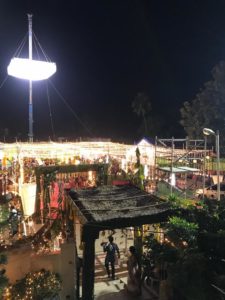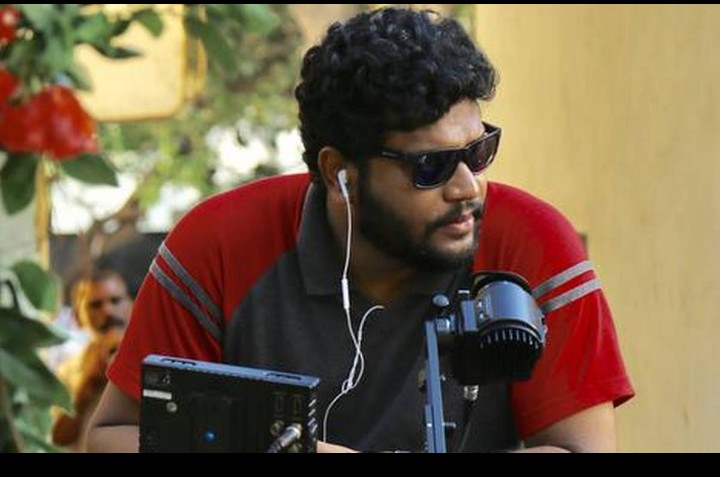
In Conversation with Sujith Sarang
May 11 2020
Sujith Sarang one of the young Dops who shot to fame and did all south Indian languages in a brief period of time.
His cinematography techniques in D16 and Dear Comrade was in high order.
In conversation with SICA
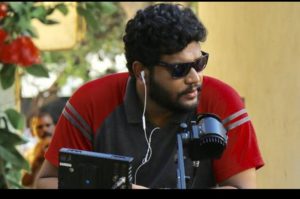
Sujith share about your beginning stage and how you got into cinematography.
A : When I was doing my final year of under graduation in Physics, my brother, editor-colorist Sreejith Sarang who was studying animation back then, suggested me to join a film school. I had no knowledge about cameras and film making. I joined MGR Film institute, Adyar and did my diploma in cinematography. Then I worked in two Ad films and the DI of the film Kaadhal solla vandhen shot by cinematographer Raanaa. Then I got the chance to shoot short films of director Arun Kumar of Pannaiyarum Padminiyum fame in Naalaiya Iyakkunar. Then I started shooting feature films like Thaaka Thaaka and Telugu movie Alias Janaki, which won Nandi awards. Eventually, Dhuruvangal 16 happened.
Q : How were you able to pull off the nuances in your earlier films, despite the fact that you came up on your own ?
A : I was deeply influenced by my father’s paintings from my childhood. So I was always confident about composition, perspective and color sense. Shooting short films gave me the idea of lens ranges. Working with limited equipment and minimal lights pressed me to come up with creative ideas with available resources. As I did not assist anyone for a sizeable time, some of my classmates supported me while I began shooting feature films in handling the logistics of the film shoot.
Q : What are all the apprehensions you had while shooting your first Tamil film Thaaka Thaaka ?
A : Before entering mainstream film making, my approach towards shooting short films and music videos was more of an indie style, with whatever equipment that is available. Out of curiosity I learnt every single day shooting Thaaka Thaaka on a trial and error basis and grew more confident. While shooting and looking at the rush of D 16, I realised how cinematography could change our perception towards life and took it up more serious. It was a huge transformation for me personally. In Thaaka Thaaka, I used to read only the particular scene to be shot and shoot it, but D 16 taught me to maintain a graph by keeping the previous scene and next scene in mind to travel with the overall mood of the film.
Q : What aspect did you feel as a challenge while reading the script of D 16 ?
A : The major part of the film revolves around a very few locations. So, some shots could possibly look monotonous and boring. To avoid that was the prime challenge to me. We planned and shot some lengthy shots to make it more engaging and interesting.
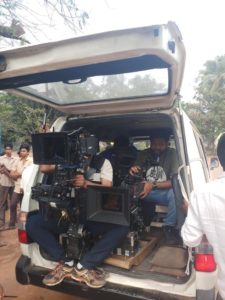
Q : The rain sequence in D 16 was shot very aesthetically. What are all the factors you kept in check to achieve it ?
A : My core idea was to shoot it as real as possible. Since the scenes were written on an intense and mysterious tone, I treated it dark with only practical lights and a back light to light up the rain. I did not hesitate to leave the subjects as silhouettes and so avoided lighting up faces in many shots. It supported well to elevate the mood of the sequence. I was also keen on maintaining the angle and density of the rain to make all shots look more cohesive. Shutter angle was maintained between 45 degree – 90 degree to get a crisp look of the rain drops.
Q : What lights did you use to shoot the rain sequence ?
A : Since we had budget constraints, I predominantly used tungsten lights with CTB gels and enhanced it a bit in the grading. I also used a 4kv PAR light from a 40 feet crane as a back light for rain. The sharpness of the light beam from the Fresnel tungsten units gave a very distinctive result.
Q : How do you start your night exterior lighting ?
A : I start with deciding the whereabouts of practical sources like lamps, tubes, etc., that suit the location. Then I decide what my ambient light is, it may be a moonlight or a warm light motivated from a source or even colourful lights from a neon board. I discuss it with the production designer in advance and create them. I light the faces of artistes matching the practical sources. I always keep an eye on realism, I don’t like crossing the line unless the script demands. For instance, I used a lot of colors in terms of lighting in Taxiwala, as it had a fantasy element in it. It had a character named Hollywood living in the garage. Grasping an idea from that, I treated the garage like a motel with neon boards we see in Hollywood movies. Hence I used a lot of colors, while maintaining the darkness on the other hand. Red light was used inside the car whenever the car gets possessed.
Q : Taxiwala had piracy issues followed by negative talks before the release. What kind of pressure did you undergo in the post-production ?
A : A three and a half hour rough cut of the film, without any CGI or grading got leaked on the internet from some data centre. Many people saw the unfinished product and commented negatively about the film. Even people we know declared it a disaster directly to us. It was very heart breaking as we had been working on it for almost one year. But still we were confident on the final product and worked hard to achieve the best output, despite the anxiety. Once the film got released, the reception was totally different. People started celebrating the film and it turned out to be a hit. It made me realise the fact that how vital cinema is to Telugu audience.
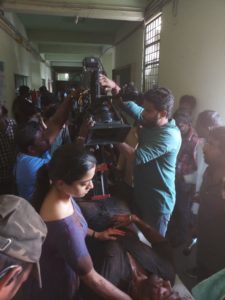
Q : Can you share the working experience of Naragasooran ?
A : The entire movie was shot in 40 days at Ooty. As it was winter, the temperature ranged about 5 degree Celsius which added further challenge in shooting rain sequences. Lighting the exteriors in Ooty was like painting in a pitch-black canvas. Every practical light source was created by us and so the terrain demanded twice the time to light up. We also had lighting call sheets to light up some large spaces. Since we had a well-prepared precise shot division, we managed to complete the shoot in a very short span. In addition to rain, we also shot in fog.
Q : What was the lighting package used for Nagasooran ?
A : We used 6kv PARs, 4kv PARs, 1.2 PARs, 575s, Kino Flos and a bunch of Tungsten lights including a 9 bunch Dino. A 12kv PAR was used for a night sequence for four days. We lit up an extensive area of a forest using space lights. I always become anxious if some equipment or light that is not necessary for the shoot is on the set, so I hire only that is absolutely necessary.
Q : Can you share the experience of your film Dear Comrade ?
A : Dear Comrade, being an emotionally driven movie, my foremost motive was to encapsulate the emotions of the characters as authentic as possible. The director of the movie, Bharat Kamma is a long-term friend of mine. As we have made a short film named Maroprapancham in 2012, we share a good rapport and have absolutely no inhibitions in sharing ideas. After 6 years, we teamed up for his debut movie, Dear Comrade. I signed the movie in 2017 itself and we started rolling it by the mid of 2018.
Q : The visuals of the Ladakh song were very pleasing. How did you approach it ?
A : We just had a basic idea of the song and we developed the montage shots during the recce. We shot a schedule of 7 days at Ladakh with just about 10 crew members. Initially I shot the song in the aspect ratio 2.85:1. Though it was visually interesting, later I felt that it disturbed the flow of the movie and so I cropped it to 2.39:1. Shooting in Ladakh necessitated a lot of travelling and location shifts, so no extra equipment was carried. The entire movie was shot with Arri Alexa SXT, but the less oxygen level and low atmospheric pressure there, made me choose Red Helium 8K, considering its light weight. We also used a DJI Inspire 2 to film aerial shots.
Q : How was shooting on Red Helium, as you generally prefer Alexa ?
A : It has quite a good resolution and dynamic range. As there were several handheld and bike rig shots, the handy size of the camera was very supportive to us. I am open to experiment with whatever that is suitable for the script. For instance, I shot my previous film MNMN entirely on Blackmagic Ursa Mini Pro 4.6K camera. I did a test shoot with it, graded the footage and I was happy with the output. I have also used Blackmagic Pocket cinema camera 6K for some portions in the bilingual film that I am currently shooting. The base of every camera is pretty good these days, how we use them to the best is what matters at the end.
Q : How do you choose the lenses for each project of yours ?
A : It totally depends on what the script demands and the way we shoot. Every lens has its own advantage and I try to use it to the fullest. Generally, I go with Ultra primes as they are light, have very less focus issues and are so convenient for handheld shots. I shot Taxiwala completely on Master prime lenses. They are fast lenses and have better optics resulting in a significant advantage for night shoots. The Master Anamorphics used in Dear Comrade had extraordinary sharpness and color rendition. Samyang Xeen lenses were used for my previous film MNMN and I am currently shooting a film with Master primes and Hawk Anamorphic lenses combined.
Q : Tell us about the Moon light rig that you created for Dear Comrade.
A : I planned to create a moon ambient lighting effect for a song sequence, but could not acquire balloon lights due to a lot of production and practical constraints. As we were on our own, we decided to make our own customised metal rig with provisions to fix multiple lights. I planned the working exposure and chose the lights to be fixed accordingly. The knowledge of general physics and sketching helped me in designing the rig methodically. Considering the weight of the lights and their ballasts, the materials with appropriate tensile strength and durability were chosen. The rig was welded and made a finished product by local welders of the village under our supervision. The cumulative weight of lights, ballast and the rig was estimated to be 450kgs. To lift such a hefty setup, we needed a sturdy industrial crane. As the shooting location was near the coastal area, it was convenient for us to hire a container lifting crane. We rigged three 4kv PAR lights and one 1.2 PAR light and positioned them accordingly to get the right angle of light. We wrapped the bottom of the rig with 40x40ft chimera cloth to make it a large diffused light source. We tested the setup for two consecutive nights after shoot by hanging it for 5-6 hours and made sure it worked flawlessly. It was hung at a height of 100ft from the ground like a chunk of moon hanging overhead illuminating an area of 100x100ft with an exposure of f/4+. As we had to film in various frame rates which involved high speed shots, that was the exposure we planned for. Safety was my primary concern, as the shoot involved a cast and crew of nearly 300 people. So we made sure that the strapping belts, metal wires, counter ropes in the respective positions were used properly. With that, we were able to turn the camera 360 degrees without any hassle and still get the same lighting effect. We did twice the work in half the time to finish up the process of rigging the lights, lifting the setup and shooting, in just one single night considering a bunch of practical difficulties. This setup cost us just ₹ 35,000 and was time efficient, whereas a helium balloon would have cost us a lot of both. Regardless of the fact that the execution of this “Poor man’s Moon” was onerous as it involved a number of challenges, solving them one after the other and obtaining the desired output was really a venturesome experience.
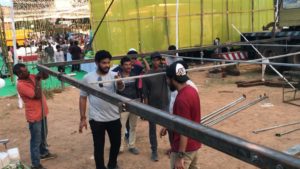
Q : The single shot canteen song in Dear Comrade must have been challenging to shoot. Can you share us the process behind it ?
A : It was indeed challenging, as it involved some complex movements through narrow space. Adding to it was the weight of Alexa SXT with Master Anamorphic lens, as I shot it completely handheld. I opened the roof for letting in ambient light. Lights positioned through the windows were panned and moved according to the movement of the camera. We rehearsed again and again with the actors, dancers, lights and made sure everything was in sync. It took us nearly 35 takes to pull it off and it looked organic on screen. It was the result of a good team effort.
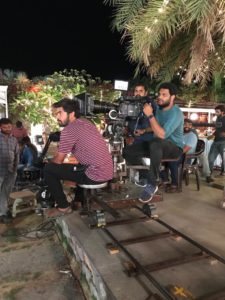
Q : How do you choose the color palette of your films ?
A : I am always very particular about the colors that I use, as it sub-consciously plays with the psychology of the audience. Once I read the script, I decide the colors to be used and avoided based on the traits of the characters and arrive on a mood board. I discuss with the costume designers in advance and choose the tones. For instance, in Dear Comrade earthy tones were used for the male lead’s costume and pastels were given for the female lead. I also discuss the shades to be used in the walls, windows and other set props with the production designer. It requires an immense planning in the pre-production phase.
Q : How do you approach the color grading process of your films ?
A : In my opinion, color grading is just a tool of enhancement and I do not solely depend on it. I always strive to push myself and my fellow technicians to accomplish the most in the phase of shooting itself, as it makes the grading or for that matter, any kind of post-production process easier and time efficient. The image quality is another big thing that will be on stake if a lot is tweaked in grading.
Q : What are your thoughts about LED lights ?
A : As the world moves fast, we keep on looking for better stuff that makes our work easier and efficient. LED lights are the result of such an evolution I would say. Firstly, they are handy and can be operated with small batteries, so less power and cost efficient. LEDs will be very beneficial for shooting on a low budget. Recently I tested Aputure 300D LED light in a shoot which gave me an illumination equivalent to that of a 1.2 PAR light. I believe that LED lights will make a revolution in cinematography in the near future.
Article drafted by : Karthik Pandian
Conversation concept:CJ.Rajkumar and Mahesh Muthuswami.

